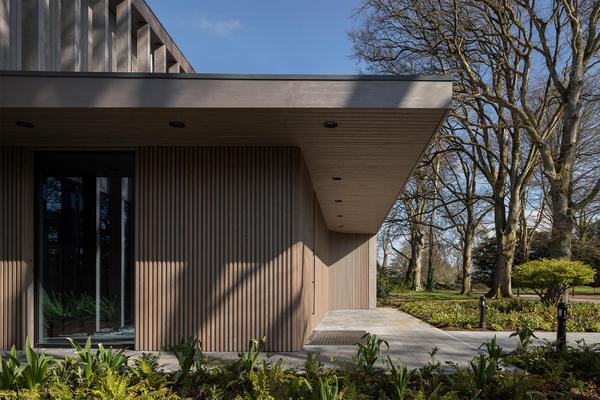The Padel Club / Healy Partners Architects
Text description provided by the architects. The existing site axes, prevailing winds, annual solar paths, protected structures, vistas, and landscape have determined the building's location, orientation, size, form, and materiality.
We are of the strong opinion that nature should have a life of its own and that we as architects should strive to bring nature and people together. The hotel guest using this facility experiences a sense of the existing woodlands while exercising at the base or in the canopy of the mature trees. The building incorporates large areas of glazing that create a synergy between the inside and outside allowing one to look through the glass framing the nature setting.
Materials such as wood, glass, and limestone were carefully chosen to ensure that the building and site context would be seamlessly integrated. The design approach was to nestle the building into a mature woodland setting.
The pavilion-like building sits on a low-lying plinth that unifies the building with the surrounding topography while giving a sense that the structure is floating above the protected landscape. The plinth occupies the basement level and is semi-submerged to take advantage of a natural fall of more than 2500mm across the existing site. This level difference is used to accommodate the services required for the operation of the building and the pool.

The proposed building mass is divided into three volumes. The form alone was not the aim of the design but instead, the form followed the function of the internal spaces.
The main volume addresses Beechwood Avenue and is parallel to the existing axis of the historic estate. This volume accommodates the main reception, a golf simulation space, two padel tennis courts, a gym, and a yoga/pilates studio. The volume is orientated East/West to avail of solar gain. The padel courts open to the east at a low level bringing the filtered morning light through the trees of Beechwood Avenue.
Internally the concept is for the users to always have a sense of place and orientation. With the building opening to the landscape, the users can have visuals of Beechwood Avenue, sweeping parklands, mature trees, and in some instances back to the hotel itself. The indoor and outdoor spaces are interwoven to enhance this natural experience.
The gym and studio are located on the first floor and incorporate floor-to-ceiling glazing as hotel guests get an opportunity to exercise in the canopy of the trees. As the seasons change, the internal experience changes.
To enhance solar protection, increase privacy internally, and assist in blending the structure into its immediate context, the external envelope is that of pretreated timber glue-laminated vertical fins. The fins are 150mm x 350mm in dimension and are treated to mimic the verticality and colour of the existing trees. To further merge the building with the mature landscape, this volume is cladded in larch timber which has also been pretreated.
The hydro activities occupy the second volume and this runs parallel to the padel tennis courts. The activities include a swimming pool, hydro pool, sauna, steam room and relaxations areas. The building envelope opens to the North to avail of the natural parkland beauty of The Adare Manor landscape with vistas over the undulating landscape and to the neighbouring Adare Desmond Castle and the Augustinian Friary. Opening the pool to the north enhances the quality of the internal space by filling it with a diffused natural light but prevents the space from a direct south light which in the pool environment would result in overheating and glare. This volume again is cladded with vertical timber cladding, but the profile of the cladding differs from the main volume creating a slight differentiation between the two.
Both sets of activities are linked by a lower volume which occupies the shared spaces such as the changing areas, showering areas and back of house necessities. This volume is more solid in form due to the nature of its private functions but the concept of merging the building with the landscaping is continued.







